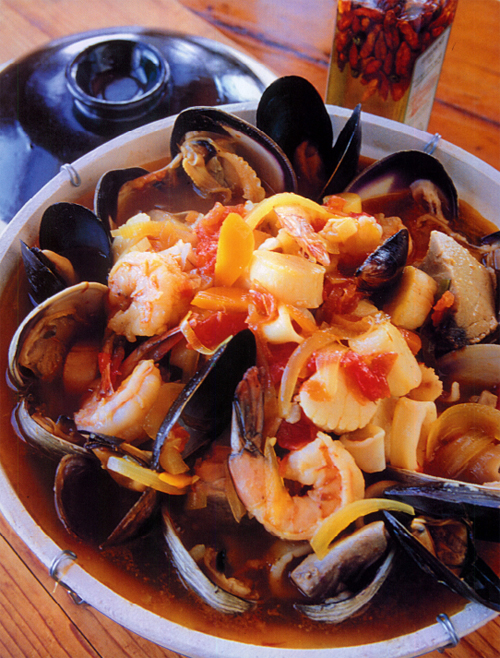 Pasta
Pasta 
Angelhair Pasta with Shrimp & Feta Cheese

This is a quick summer dish that has been on our menu for years. It’s best in August when the tomatoes are ripe and have the most flavor, although most grocery stores have vine-ripened tomatoes year ’round. If the shrimp are prepped ahead of time, you can throw this dish together in about twenty minutes.
3 to 5 cloves of garlic, chopped
3 tablespoons olive oil
1 pound small shrimp, peeled and deveined (see page 96)
¼ cup dry white wine
4 ripe tomatoes, diced
small bunch of fresh basil leaves
1 tablespoon salt
8 ounces feta cheese, crumbled
1½ pounds of angelhair pasta (two 12-ounce packages)
salt and pepper to taste
- Bring six quarts of water to a boil on high heat.
- Sauté garlic in the olive oil over high heat until fragrant. Add shrimp and sauté briefly, just until the shrimp are pink.
- Add the wine and let cook down briefly. Add the diced tomatoes, and lower the heat.
- Tear the basil leaves into the sauce and add the feta cheese. Add fresh ground black pepper and salt to taste. Be careful not to overcook because shrimp will become rubbery. Set aside.
- When pasta water comes to a rolling boil, add one tablespoon of salt and the angelhair pasta. The pasta will take about three minutes to cook, so time the sauce accordingly.
- Drain the angelhair pasta quickly leaving a bit of the water and return to its pot. Add a bit of the sauce to moisten the pasta and divide among serving plates. Add the rest of the sauce to each plate and serve.
SERVES 6

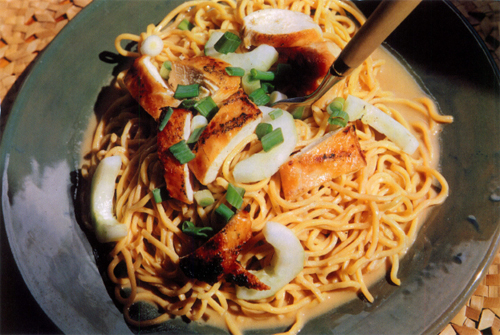
 Char~lee’s Chilled Spicy Sesame Noodles
Char~lee’s Chilled Spicy Sesame Noodles

First introduced during one of our special Chinese nights during the winter, this recipe quickly became a fixture on our summer menu. It is probably Charlie’s (a/k/a Char-lee’s) most requested recipe ~ people stop him on the street and walk away with ingredients jotted on a scrap of paper. It makes nearly a quart of sauce and you’ll be glad for the volume, because it keeps at least two weeks refrigerated and improves with age. You can use the sauce on stir-fried veggies or for a quick snack on cold noodles. You can also cut the recipe in half or double it easily.
1 pound fresh or dried egg noodles
1 cup tahini (tahini tends to separate; mix before measuring)
1 cup hot water
1 cup canola oil
1 cup tamari or soy sauce
½ cup sugar
½ cup vinegar (cider and/or red wine)
¼ to ½ cup chili oil (depending on how hot you want it)
2 tablespoons dark sesame oil
5 cloves garlic, peeled and chopped
3 scallions, chopped (for garnish)
Optional:
1 cucumber, peeled, seeded and sliced
1 grilled, sliced boneless chicken breast
2 tablespoons sesame seeds
- Cook egg noodles in six quarts of boiling, salted water for about 3 to 5 minutes for fresh or 7 to 10 minutes for dried. Drain and rinse in cold water. Add a drizzle of sesame oil to prevent sticking. Chill.
- Pour the cup of tahini into a large mixing bowl. Add the cup of hot water to the measuring cup, stir to clear any tahini left in the cup, and add to the bowl. Blend with a wire whisk until smooth.
- Whisk in the vegetable oil to blend. Add the tamari, sugar, and vinegar, one at a time, blending with the whisk after each addition.
- Add the chili oil starting with ¼ cup. Taste for spiciness. Add more if you like.
- Add the sesame oil and garlic. Blend.
- Divide the chilled noodles among four plates. Add enough sauce to coat, and garnish with chopped scallions and any optional ingredients. Enjoy! (Don’t forget to refrigerate the remaining sauce.)
SERVES 4 AS A MAIN COURSE OR 6 AS AN APPETIZER
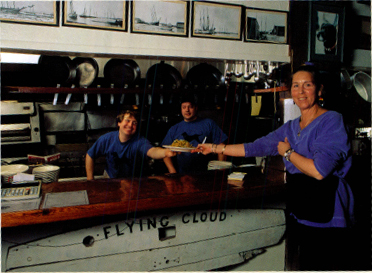
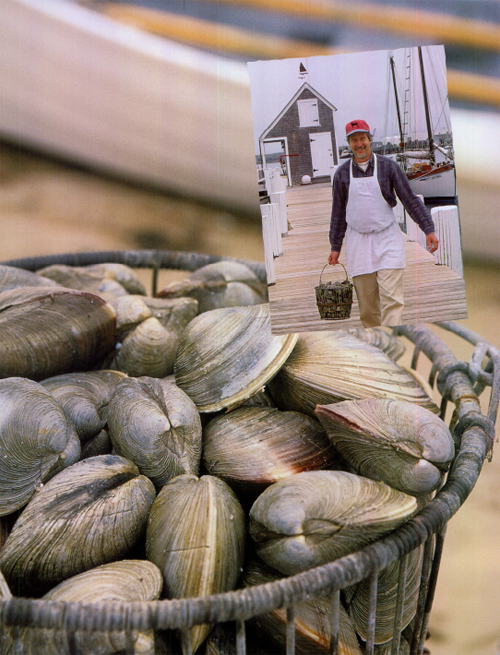
Linguine with White Clam Sauce

More than a classic ~ just taste our version and you’ll see why it will always be on The Black Dog menu! If you decide to add the chilis, be sure to wash your hands after mincing them ~ any contact with your eyes should be avoided.
28 littleneck clams, scrubbed
7 cloves garlic, minced
2 tablespoons extra virgin olive oil
2 small hot chilis, minced (a tasty option)
½ cup dry white wine
freshly ground black pepper to taste
½ cup chopped fresh parsley
¼ cup chopped fresh basil
1 to 1½ pounds linguine
1 tablespoon salt
- Bring six quarts of water to a rolling boil and add 1 tablespoon salt.
- Open 24 of the clams over a bowl with a sieve to strain the clam liquid. Save 4 clams for garnish. Set the strained liquid aside and chop the clams to a mince.
- Add the linguine to boiling water. The clam sauce should take the same length of time to cook as the linguine.
- Sauté minced garlic in the olive oil over high heat, being careful not to burn it. Add the minced chilis if you like a spicy sauce.
- Add the minced clams and sauté to heat through, then add the black pepper and white wine. Now add the reserved clam liquid.
- Open the last four clams without detaching the clams from their shells, and toss them into the sauce. (Opening them helps the clams to cook quickly. See “How to Open Clams” on page 118.)
- Add the parsley and basil. Lower the heat to medium.
- When the linguine is al dente, drain it and toss it with about half of the sauce.
- Divide the pasta onto four plates, add the remaining sauce, and garnish each plate with one of the whole clams.
SERVES 4
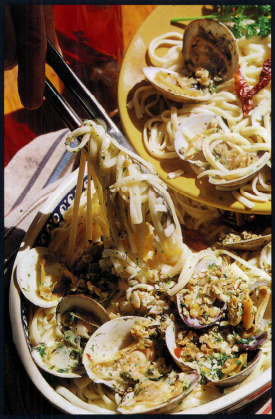
 Ravioli Pomadoro
Ravioli Pomadoro

This dish celebrates our native American tomato as the golden fruit ~ not in color, but in its value to so many dishes. If vine-ripened tomatoes are not available, use canned roma tomatoes for the best flavor.
½ tablespoon salt for pasta water
2 tablespoons virgin olive oil
¼ to ½ teaspoon crushed red pepper
2 garlic cloves, chopped
1 medium red onion, chopped
4 to 6 large fresh tomatoes, chopped
10 to 12 fresh basil leaves, cut in strips
salt and pepper to taste
1 cup sliced white mushrooms
1 pound of your favorite fresh ravioli or pasta grated Parmigiano-Reggiano
fresh basil for garnish
- Bring 4 quarts of water to a boil and add salt.
- Combine the olive oil and crushed red pepper in a large sauté pan and heat until smokin’ hot.
- Add the garlic and onions to the hot oil and sauté until translucent. Add the tomatoes and basil. Add salt and pepper to taste.
- Continue cooking until the mixture is reduced by half.
- Add the mushrooms to the tomato mixture and continue cooking for about three minutes. Now is the time to add ravioli or pasta to the boiling water, since fresh pasta usually cooks in about three minutes.
- Drain pasta and top with the sauce. Garnish each serving with grated Parmigiano-Reggiano and fresh basil.
SERVES 4

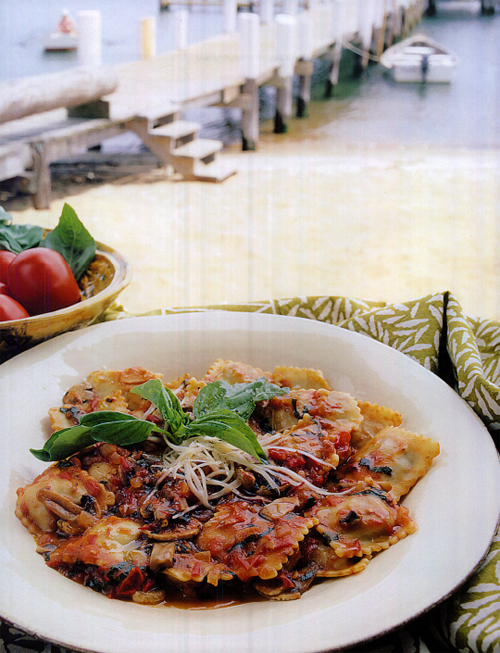

 Penne with Shiitake Mushroom Sauce
Penne with Shiitake Mushroom Sauce

We always start with the freshest and the best ~ the real secret to great food. Island-grown tomatoes have always been easy to come by, but mushrooms? That’s where Matt Dix and Rebecca Miller’s endeavors helped enrich our menu. Since 1994, we’ve had the luxury of locally grown shiitake mushrooms. At North Tabor Farm, in a shady spot on the north side of the Island, Matt and Rebecca have created a natural habitat for the shiitake to thrive. Using oak logs from the State Forest and shiitake spores, their mushrooms grow up to 3 inches in diameter. Rebecca, who spent her summer vacations during college working at The Black Dog, proudly states “Our shiitake grown on logs in a natural environment are much bigger and richer than the supermarket kind, and really meaty. They are wonderful.” We agree!
½ ounce dried shiitake mushrooms
1 cup hot water
½ pound fresh shiitake mushroom caps
1 large portobello mushroom
1 pound fresh plum tomatoes
1 pound penne
1 tablespoon salt
6 tablespoons extra virgin olive oil
5 minced garlic cloves
ground black pepper to taste
1 cup white wine
10 basil leaves
½ teaspoon salt
grated Romano cheese
- Pour one cup of hot water into a small bowl. Add the dried shiitake mushrooms and set aside to soak and rehydrate for about ten minutes.
- Slice the fresh shiitakes and fresh portobello. When the dried shiitakes are soft, squeeze out any excess water. Reserve all the soaking liquid. Slice the soft shiitakes. Dice the tomatoes into large cubes.
- Bring six quarts of water to a boil. Add 1 tablespoon of salt and the penne. Cook for approximately 10 minutes, until al dente.
- While pasta is cooking, heat the olive oil in a heavy saucepan or deep cast iron skillet. Add the garlic and black pepper. Stir to keep the garlic from burning.
- Add the sliced fresh mushrooms to the pan and stir to coat with the oil. Now add the softened shiitake slices and diced tomatoes.
- Pour in white wine, stir for a minute, and then add the reserved mushroom soaking liquid.
- Tear the basil leaves and stir into the pan. Add ½ teaspoon salt and bring the heat down to a low simmer. Continue cooking for about three to five minutes.
- Serve penne with mushroom sauce and grated cheese.
SERVES 4


 Linguine with Pesto
Linguine with Pesto

August is the time for basil ~ and that means pesto. Most summer afternoons at The Black Dog you can find Nancy Oh picking through a bushel or two of fresh basil from Whippoorwill Farm, carefully removing the leaves from the stems. Pesto making is a snap with a blender or food processor; you can have the sauce ready in minutes. If you have the time on a lazy summer afternoon try making it old-world style with a mortar and pestle. It may take longer, but the texture will be closer to its Genovese origins and the taste will be sweeter, since the oils from the basil, pinenuts, and garlic blend more slowly. Make sure to use the smaller tender basil leaves and save the larger ones for tomato sauces or roasting new potatoes. Add a diced vine-ripened tomato at the end, either directly onto the pasta or blended into the pesto. The acid from the tomato will cut some of the oiliness of the sauce. If you’re not going to serve it right away, wait to add the cheese. Make a large batch and freeze it in serving-size containers. You add the cheese when you’re ready to enjoy your pesto for a taste of hot summer days in January. Pesto is great as a substitute for tomato sauce on pizza ~ use fresh beefsteak tomato slices as a topping. It’s also good served over grilled bluefish fillets.
2 tablespoons pinenuts
1 cup extra virgin olive oil
5 to 7 cloves garlic
3 cups fresh basil leaves
½ teaspoon sea salt
ground pepper to taste
3 tablespoons Parmigiano-Reggiano
1 ripe tomato (optional)
1 pound linguine
1 tablespoon salt
- Toast the pinenuts over high heat in a dry skillet. Keep the pan and the pinenuts moving so they don’t burn. This should take a minute or two.
- Preheat your oven to 425°F. Drizzle a little olive oil on the unpeeled garlic cloves and roast until soft, about five minutes. This gives the garlic a sweeter, less biting taste.
- Peel the garlic and add to a food processor or blender along with the toasted pinenuts and a little of the olive oil. Process briefly to a coarse texture.
- Add a third of the basil leaves and a third of the olive oil and process on a slow setting. Continue this until all the basil and olive oil has been added. Add sea salt and pepper.
- If you’re serving the pesto soon, add the cheese and the optional ripe tomato.
- Bring six quarts of water to a rolling boil and add 1 tablespoon of salt. Add the linguine, cook for about 10 minutes, until al dente. Drain and toss the cooked linguine with a little of the pesto. Divide onto plates and add the rest of the pesto on top. You can add more grated cheese, as desired.
SERVES 4

 Penne Sautéed with Broccoli Rabe & White Beans
Penne Sautéed with Broccoli Rabe & White Beans

In years past, broccoli rabe was only available in late spring and early fall. Now you can find it year ’round in most areas. It has a bite ~ slightly bitter ~ that we love, and adds dimension to this tasty vegetarian combo. If you’ve never tasted it before, try it before you make this dish. It’s not to everyone’s taste.
1 pound cannelloni (a/k/a white kidney beans)
1 bunch broccoli rabe
1 tablespoon salt
1 pound penne
1 tablespoon of salt
2 tablespoons olive oil
1 tablespoon chopped garlic
salt and pepper to taste
Parmigiano-Reggiano
- The day before you plan to serve, soak the pound of beans overnight in four times their volume of water. Drain.
- To cook, cover the beans in fresh water and bring to a boil. Reduce the heat to maintain a simmer, and cook until the beans are tender but still slightly firm. This should take about 30 to 40 minutes. Remove from heat and chill the beans in their cooking liquid.
- Trim off the tough fibrous ends of the rabe and discard. Bring two quarts of water to a boil. Add a tablespoon of salt.
- Place the rabe in the boiling water and stir. When the water comes back to a second boil, remove the rabe and plunge it into ice water to stop the cooking process. Reserve.
- Bring 6 quarts of water to a boil, add 1 tablespoon of salt and the pound of penne. Cook approximately 7 to 9 minutes, until al dente. Drain and keep warm.
- In a large heavy-bottom saucepan, heat the olive oil. Add the chopped garlic and sauté briefly until the garlic sizzles.
- Add the reserved broccoli rabe and sauté until heated through, about 2 to 3 minutes. Toss in the cooked beans with their liquid and heat for another 2 minutes. Season with salt and pepper to taste.
- In a large bowl or on a large platter, toss the cooked penne with the bean mixture.
- Serve with grated cheese.
SERVES 4 TO 6

 Fusilli Puttanesca
Fusilli Puttanesca

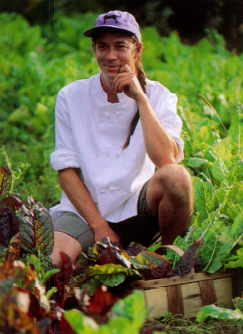
Quick, hot and spicy ~ the name of this classic pasta sauce translates to “whore’s pasta.” Not intended to be a characterization of the diner, the name is supposedly a comment on the ease and speed with which this sauce can be made. Another version of the dish’s origins refers to the fragrance of the sauce ~ so pungent, its aroma drew clients for the ladies of the night. Fun tales to share with your guests (or not); just be sure to share the sauce.
3 tablespoons extra virgin olive oil
3 anchovy fillets
2 dried chili peppers, minced, or 1 to 2 teaspoons crushed red pepper flakes
2 tablespoons capers
7 cloves garlic, minced
12 oil-cured black olives
1 can Italian style, whole, plum tomatoes (28 ounces)
fresh ground black pepper to taste
2 tablespoons dried oregano
7 fresh basil leaves
1 to 1½ pounds fusilli
1 tablespoon salt
- Heat olive oil in a large saucepan over high heat. Add the anchovies and let them dissolve in the oil for a minute.
- Add the chilis, capers, garlic, and olives. Stir and cook for about a minute.
- Drain the liquid from the tomatoes into the saucepan. Coarsely chop the tomatoes or squeeze with your hand into the saucepan. Stir to heat through, season with black pepper, and lower the heat to medium.
- Add the oregano to the sauce by rubbing it between your hands and dropping it into the tomato mixture. Tear the basil leaves into the sauce. Stir and taste. Correct seasoning.
- Bring 6 quarts water to a boil. Add salt. Add the pasta to the boiling water and cook until al dente, drain, and toss with a bit of the sauce to keep it from sticking.
- Divide the pasta onto four or more plates and dress with the rest of the sauce.
SERVES 4 TO 6

